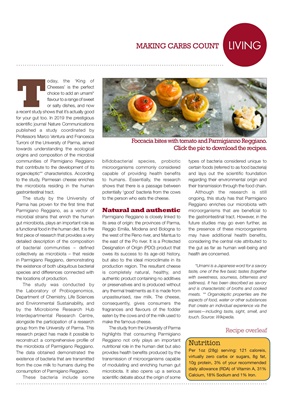
KITLIVING
Today, the 'King of
Cheeses' is the perfect
choice to add an umami*
flavour to a range of sweet
or salty dishes, and now
a recent study shows that it's actually good
for your gut too. In 2019 the prestigious
scientific journal Nature Communications
published a study coordinated by
Professors Marco Ventura and Francesca
Turroni of the University of Parma, aimed
towards understanding the ecological
origins and composition of the microbial
communities of Parmigiano Reggiano
that contribute to the development of its
organoleptic** characteristics. According
to the study, Parmesan cheese enriches
the microbiota residing in the human
gastrointestinal tract.
The study by the University of
Parma has proven for the first time that
Parmigiano Reggiano, as a vector of
microbial strains that enrich the human
gut microbiota, plays an important role as
a functional food in the human diet. It is the
first piece of research that provides a very
detailed description of the composition
of bacterial communities - defined
collectively as microbiota - that reside
in Parmigiano Reggiano, demonstrating
the existence of both ubiquitous bacterial
species and differences connected with
the locations of production.
The study was conducted by
the Laboratory of Probiogenomics,
Department of Chemistry, Life Sciences
and Environmental Sustainability, and
by the Microbiome Research Hub
Interdepartmental Research Centre,
alongside the participation of a research
group from the University of Parma. This
research project has made it possible to
reconstruct a comprehensive profile of
the microbiota of Parmigiano Reggiano.
The data obtained demonstrated the
existence of bacteria that are transmitted
from the cow milk to humans during the
consumption of Parmigiano Reggiano.
These bacteria include some
Per 1oz (28g) 121 caloreis, virtually zero
carbs or sugars, 8g fat, 10g protein, 3% of
your recommended daily allowance (RDA)
of Vitamin A, 31% Calcium, 18% Sodium
and 1% Iron.
Nutrition
MAKING CARBS COUNT
bifidobacterial species, probiotic
microorganisms commonly considered
capable of providing health benefits
to humans. Essentially, the research
shows that there is a passage between
potentially 'good' bacteria from the cows
to the person who eats the cheese.
Natural and authentic
Parmigiano Reggiano is closely linked to
its area of origin: the provinces of Parma,
Reggio Emilia, Modena and Bologna to
the west of the Reno river, and Mantua to
the east of the Po river. It is a Protected
Designation of Origin (PDO) product that
owes its success to its age-old history,
but also to the ideal microclimate in its
production region. The resultant cheese
is completely natural, healthy, and
authentic product containing no additives
or preservatives and is produced without
any thermal treatments as it is made from
unpasteurised, raw milk. The cheese,
consequently, gives consumers the
fragrances and flavours of the fodder
eaten by the cows and of the milk used to
make the famous cheese.
The study from the University of Parma
highlights that consuming Parmigiano
Reggiano not only plays an important
nutritional role in the human diet but also
provides health benefits produced by the
transmission of microorganisms capable
of modulating and enriching human gut
microbiota. It also opens up a serious
scientific debate about the origin of some
Foccacia bites with tomato and Parmigianno Reggiano.
Click the pic to download the recipes.
Recipe overleaf
types of bacteria considered unique to
certain foods (referred to as food bacteria)
and lays out the scientific foundation
regarding their environmental origin and
their transmission through the food chain.
Although the research is still
ongoing, this study has that Parmigiano
Reggiano enriches our microbiota with
microorganisms that are beneficial to
the gastrointestinal tract. However, in the
future studies may go even further, as
the presence of these microorganisms
may have additional health benefits,
considering the central role attributed to
the gut as far as human well-being and
health are concerned.
*Umami is a Japanese word for a savory
taste, one of the five basic tastes (together
with sweetness, sourness, bitterness and
saltiness). It has been described as savory
and is characteristic of broths and cooked
meats. ** Organoleptic properties are the
aspects of food, water or other substances
that create an individual experience via the
senses-including taste, sight, smell, and
touch. Source: Wikipedia.